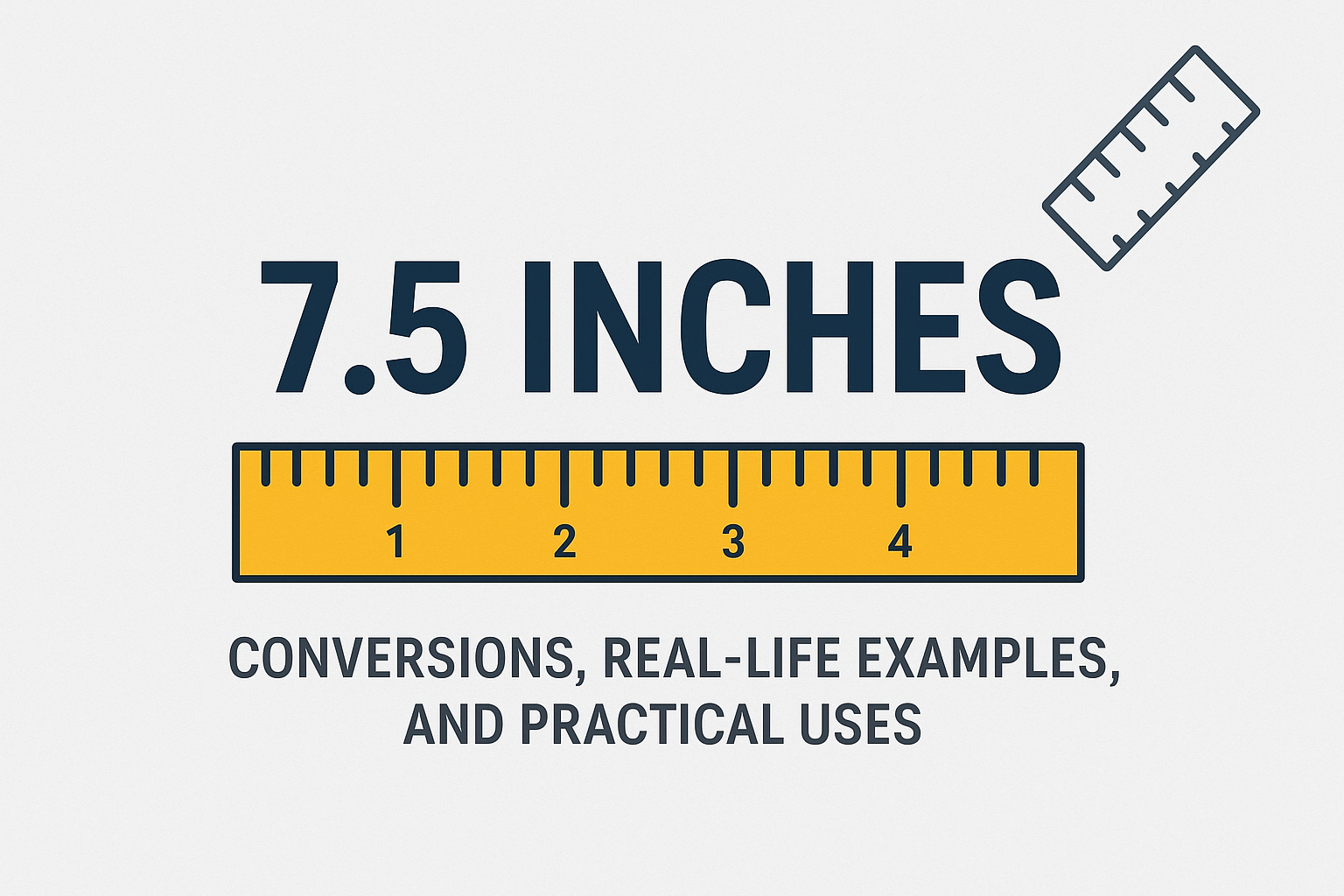When it comes to measurements, precision matters. Whether you are working on a craft project, buying furniture, or just curious about object sizes, knowing exactly how long 7.5 inches is can save you from making mistakes. In this detailed guide, we’ll explore what 7.5 inches means, how to convert it into different units, real-world examples of items with this measurement, and why understanding it can be more important than you think.
1. What Exactly is 7.5 Inches?
An inch is a unit of length primarily used in the imperial and US customary systems of measurement. One inch equals 2.54 centimeters, so when we talk about 7.5 inches, we are referring to a length that is slightly over 19 centimeters.
Mathematically:
CopyEdit
7.5 inches × 2.54 cm = 19.05 cm
This means if you were to take a ruler marked in centimeters, 7.5 inches would align closely with the 19.05 cm mark.
For a deeper breakdown on inch-to-centimeter conversions, you can refer to this helpful inches to centimeters conversion guide.
2. How to Visualize 7.5 Inches
Sometimes numbers don’t mean much until we compare them with familiar objects. Here are some items that are approximately 7.5 inches long:
- A standard pencil from tip to eraser before sharpening
- Most tablets or e-readers diagonally (like Kindle Paperwhite)
- A small dinner plate’s diameter
- The width of a medium-sized hardcover book
- The length of a large smartphone or mini remote control
For a more extensive list of items that measure 7.5 inches, check out this reference: Things That Are 7.5 Inches Long.
3. Why 7.5 Inches Matters in Daily Life
You might be wondering—why should anyone care about 7.5 inches specifically? Here’s why:
a) Design & Crafting
In DIY projects, sewing, or woodworking, 7.5 inches might be a precise measurement for parts and patterns. For example, if you’re sewing a handbag strap or cutting a wooden frame, the difference between 7 inches and 7.5 inches can affect the final outcome.
b) Gadgets & Electronics
Tech companies often list screen sizes in inches. A device labeled as 7.5 inches likely refers to its diagonal screen measurement, which is crucial for buying the right case or stand.
c) Furniture Fitting
When planning furniture layout, every inch counts. If you’re measuring space between shelves or for decorative items, 7.5 inches could determine if something fits perfectly or not.
4. Converting 7.5 Inches into Other Units
While inches are widely used in the US and a few other countries, many parts of the world prefer centimeters or millimeters. Here’s how 7.5 inches converts into other units:
| Unit | Equivalent Measurement |
| Centimeters | 19.05 cm |
| Millimeters | 190.5 mm |
| Meters | 0.1905 m |
| Feet | 0.625 ft |
| Yards | 0.2083 yd |
Quick tip:
- To convert inches to centimeters, multiply by 2.54.
- To convert inches to feet, divide by 12.
5. Common Uses of the 7.5-Inch Measurement
a) Stationery
Some notebooks, planners, and sketchpads are 7.5 inches tall or wide, making them portable yet spacious.
b) Sports Equipment
Certain tennis racquet heads and baseball gloves may have dimensions close to 7.5 inches in some areas.
c) Kitchen Tools
Small frying pans, cake tins, or chopping boards often have dimensions around 7.5 inches, perfect for single servings or compact kitchens.
6. Tips for Measuring 7.5 Inches Accurately
Measuring precisely ensures you don’t waste materials or buy the wrong size. Here are some tips:
- Use a ruler or measuring tape marked in both inches and centimeters.
- Check the zero point on your measuring tool—it should align perfectly with the edge of the object.
- Measure twice, cut once—especially important for crafting or construction projects.
- If you don’t have a ruler handy, use a common item for reference, like a standard pencil (close to 7.5 inches long).
7. Fun Facts About Inches and 7.5 Inches
- The inch has historical roots in ancient Roman, English, and Scottish measurements.
- A standard credit card is about 3.37 inches wide—two of them side-by-side get close to 7 inches.
- In fashion, 7.5 inches could be the height of certain boot designs from heel to top.
8. Why Understanding Small Measurements is a Big Deal
In many situations, people underestimate the importance of smaller measurements like 7.5 inches. But in engineering, tailoring, cooking, and interior design, accuracy can make or break a project.
Think about:
- A bookshelf slot—if the book is even half an inch taller than the gap, it won’t fit.
- A photo frame—slightly larger or smaller and the picture will look awkward.
- A smartphone screen—misjudging size could mean you buy a case that doesn’t fit.
Conclusion
Whether you’re a designer, student, hobbyist, or just curious, knowing exactly how long 7.5 inches is—and how to convert it—can make your life easier. From crafting and furniture shopping to tech gadgets and cooking, 7.5 inches appears more often than you might think.
The next time someone mentions this measurement, you won’t just nod—you’ll know exactly what it means, how to visualize it, and where it might apply in real life.

